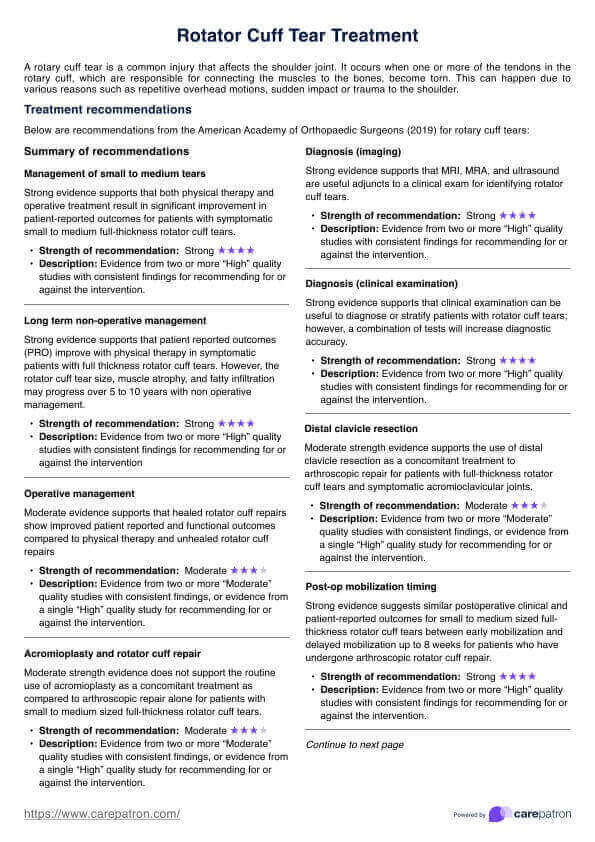Rotator Cuff Tear Treatment
Learn about rotator cuff tear treatment options and get Carepatron's free PDF download with examples to help you understand and manage this common shoulder injury effectively.


What are rotator cuff tears?
A rotator cuff tear refers to an injury affecting the group of muscles and tendons that surround the shoulder joint, specifically where they attach to the upper arm bone. It can cause arm pain and weakness. The rotator cuff, which consists of muscles and tendons in the shoulder blade, plays a crucial role in stabilizing and facilitating movement of the shoulder and rotator cuff tendons.
Torn rotator cuffs can vary in severity, from a partial tear that involves only a portion of the tendon to a complete tear that severs the tendon completely from its attachment. Common causes of rotator cuff injury include repetitive stress, trauma, or degenerative changes over time. Symptoms often include shoulder pain, especially when lifting or lowering the arm, arm weakness, and difficulty performing overhead activities.
Treatment options for rotator cuff injuries depend on the severity of the tear. More conservative treatments may include rest, physical therapy, and anti-inflammatory medications. Alternatively, more invasive treatments like arthroscopic rotator cuff repair or, in severe cases, rotator cuff surgery can also be employed. Physical therapy is typically crucial in restoring strength and range of motion in the rotator cuff tendon.
Rotator Cuff Tear Treatment Template
Rotator Cuff Tear Treatment Example
How is a torn rotator cuff diagnosed?
Diagnosing a torn rotator cuff involves several steps to accurately assess the extent and location of the injury. Healthcare providers use a combination of medical history, physical examination, and imaging tests to make a definitive diagnosis.
Medical history and physical examination
Firstly, a healthcare provider will perform a medical history check and ask about rotator cuff tear symptoms, such as shoulder pain, especially during specific movements or activities involving the upper arm bone.
During the physical examination, the doctor will assess your shoulder's range of motion, strength, and any signs of tenderness or swelling around the shoulder joint, focusing on areas where rotator cuff tears commonly occur.
Imaging tests
After the initial assessment, imaging tests are typically recommended to confirm the diagnosis and evaluate the severity of the rotator cuff tear. X-rays can reveal bone spurs or other conditions that might be causing symptoms, but the most effective imaging techniques for detecting soft tissue injuries like rotator cuff tears are ultrasound and magnetic resonance imaging (MRI). These tests provide detailed images of the rotator cuff muscles, tendons, and the shoulder joint, helping to pinpoint the location and extent of the tear.
How do healthcare professionals treat rotator cuff tears?
Treatment for rotator cuff tears varies depending on the severity of the injury and the patient's overall health. Healthcare professionals typically employ a range of strategies to alleviate pain, restore function, and promote healing.
Physical therapy
Physical therapy is a cornerstone of treatment for rotator cuff tears. It focuses on exercises to strengthen the muscles around the shoulder, improve flexibility, and enhance shoulder mechanics. This approach is beneficial for both partial and complete tears, aiming to reduce pain and restore function gradually.
Medications
Non-steroidal anti-inflammatory drugs (NSAIDs) may be prescribed to alleviate pain and reduce inflammation associated with rotator cuff tears. In some cases, corticosteroid injections directly into the shoulder joint can temporarily relieve symptoms, particularly in cases of acute inflammation.
Arthroscopic repair
For partial or full-thickness tears that do not respond to conservative treatments, arthroscopic surgery may be recommended. This minimally invasive procedure involves inserting a small camera and surgical tools through small incisions to repair torn tendons and remove any damaged tissue. It is typically preferred for smaller tears and can lead to quicker recovery times compared to traditional open surgery.
Open surgical repair
Open surgical repair may also be necessary in some cases. This involves a larger incision to access and repair the torn tendons, often using sutures or anchors to reattach the tendon to the arm bone (humerus) or shoulder blade (scapula). Open surgery may be recommended for degenerative tears or cases where the tendon quality is poor.
Shoulder replacement surgery
In severe cases where the rotator cuff tear is irreparable or associated with significant arthritis and joint damage, shoulder replacement surgery may be considered. This procedure involves replacing the damaged parts of the shoulder joint with artificial components to reduce pain and improve function.
How to use our Rotator Cuff Tear Treatment Guidelines template
Carepatron's Rotator Cuff Tear Treatment Guidelines provide a structured approach for healthcare professionals to manage and track treatment plans effectively.
Step 1: Access the template
Download the template using the 'Download now' button on this page.
Step 2: Treatment plan development
Utilize the template to outline a comprehensive treatment plan. Include details on prescribed medications, physical therapy exercises, and recommended lifestyle modifications.
Step 3: Progress tracking
Regularly update the template to monitor patient progress. Record improvements in range of motion, pain levels, and adherence to treatment protocols.
Step 4: Review and adjust
Periodically review the treatment plan using the template. Adjust interventions as necessary based on patient response and clinical assessments.
Commonly asked questions
In some cases, small partial tears of the rotator cuff can heal with rest and physical therapy. However, full-thickness tears or larger tears typically do not heal on their own and may require medical intervention.
Recovery time for a torn rotator cuff without surgery varies depending on the severity of the tear and individual factors. Significant improvement can take several weeks to months of conservative treatment, including rest, physical therapy, and possibly corticosteroid injections.
Common warning signs of a rotator cuff tear include persistent shoulder pain, especially at night or during specific movements, and weakness when lifting or rotating the arm.
Yes, many rotator cuff tears can be effectively managed without surgery, especially if they are partial tears or respond well to conservative treatments like physical therapy, medications, and lifestyle modifications.







































































































